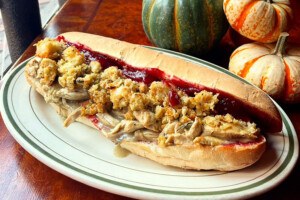Our City Chose Illegal Parking Over Its Vibrant Dining Scene
This isn't about me or my restaurant or any individual restaurant in Philadelphia, for that matter. It’s about our city.

Before and after shots of the streetery space at Mike’s BBQ / Photographs by Mike Strauss
I love Philadelphia, I love Philadelphia restaurants, I love the people who operate them and work in them. I always have. For 25 years, I’ve lived and dined here — before Garces opened Amada, before Vetri opened Osteria, before Zahav was even an idea. I’ve watched the food scene grow, mature, innovate, pivot, and become what is, in my opinion, the best destination-dining city in America. The city is affordable enough, and our chefs are brave enough to explore as their hearts desire. For those who don’t know me, I’m Michael Strauss, co-owner of Mike’s BBQ and Sidecar Bar & Grill. I’ve been part of the Philly restaurant community for over 10 years.
And so it’s with love that I write how upset I am for the loss of our streeteries in the wake of the permanent outdoor dining program’s rollout, and that I share the sadness I feel for Philly restaurants dealing with complex policy changes now. The city has let us all down. Let’s talk about it.
For operators, the pandemic was a roller-coaster ride of openings, closings, restrictions and fluctuating rules about masking and proof of vaccination. In the summer of 2020, the city government offered restaurants the ability to extend their dining rooms onto the sidewalks and into the streets as a way of helping businesses stay open and keep their guests safe. These dining options were a lifesaver for restaurants, especially with the limits on indoor dining at the time: restrictions on capacity, the spacing-out of diners — at some points, diners weren’t allowed inside unless they were wearing masks.
Some of these parking-lot structures were built with heaters and HVAC systems. Ours at Mike’s BBQ was simple: four tables with four seats each, 100-pound planters for protection from the street, and a grass carpet. Essentially, there was no structure at all. Even as indoor service returned in Philly, our outdoor dining area thrived.
The world continued to open up, and Philly’s outdoor dining policy became more complicated. At first, the city planned on letting the permits for these temporary structures expire. But restaurants and patrons insisted they stay in place. Allan Domb proposed a bill to maintain outdoor dining, and it eventually passed, allowing certain areas of the city to automatically keep them. Restaurants in the rest of the city now needed permission from their Councilperson to operate outdoor dining in a parking lane. To me, this felt like the city picking winners and losers: A restaurant located on one street could keep its structure, while the place around the corner would lose its outdoor dining just because of the location.
The Streets Department eventually updated the rules for outdoor dining in Philadelphia with fees and insurance requirements beyond the reach of any restaurant. After pushback from the restaurant community, this original proposal was readjusted with a final ruling in October 2022, with permitting and design hoops that essentially made it impossible for most restaurants to meet the requirements by the January 9th deadline. (In an email sent on Thursday, January 5th, the Department of Commerce wrote: “Note that most existing streeteries, as they are currently designed, will not meet the eligibility of the site restrictions and/or regulations.”) When the city made the outdoor dining program permanent, it felt like they were telling us: “We are here to help, but only 10 percent of you.” My restaurant is not one of those businesses.
After speaking with Councilman Mark Squilla’s office and State Representative Elizabeth Fiedler’s office, I determined that my business would need city and state legislative action to keep its outdoor dining. They both said the outcome wouldn’t be positive.
In Pennsylvania, it’s illegal to park within 30 feet of a stop sign. While this is rarely enforced, this law disqualifies our business from operating a streetery. Our state representative said she could propose a variance. However, I was warned it would likely sit in committee for a long time and then be forgotten.
In New York City, the city has spent over a year speaking with legislative groups, neighborhood associations and businesses (not just restaurants) to come up with a program that could benefit small businesses while addressing concerns over traffic safety and accessibility. Sadly, that didn’t happen here — at a time when our customer base is shrinking as the consumer is getting hit with inflation and has less disposable income. Our costs are up (by 30 to 100 percent, depending on the product). It’s been said before, but it bears repeating: Restaurants truly need every tool at their disposal to keep going.
I’m probably not the best choice in writing this, as I’m not angry. I’m not surprised. I won’t have to lay anyone off because I lost street dining. At Mike’s BBQ, we’re a help-yourself kind of shop. I have no doubt others weren’t so fortunate. Serving fewer customers means supporting fewer staff members — that’s simple restaurant math. We will continue to serve our guests and provide them with great dining experiences. But again, this is not about me or my restaurant, or any individual restaurant, for that matter. It’s about our city.
Philly is a great place to visit not because it’s a great place to park. Seeing people outside — enjoying themselves, laughing, eating — is much better than staring at cars. I know some folks want parking. I get it. I live here, too. There will never be enough parking for 100 different reasons, but I assure you, it’s not the fault of the restaurants.
Having people on the street will always make any neighborhood safer and more enjoyable. I really hoped our city leaders had a vision of Philly with a visible, vibrant dining scene that represents and shows us off as a world-class city. Choosing an empty parking spot over a bustling restaurant is disappointing.


